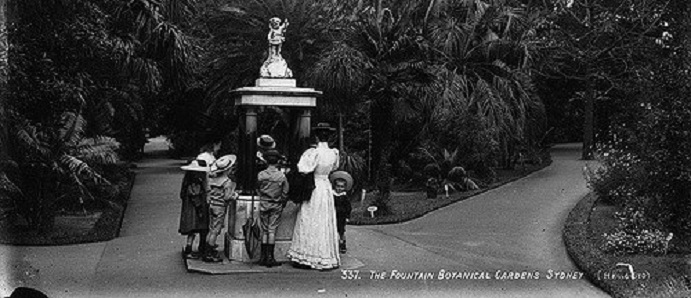Ian Willis writes about Sydney’s central parklands…
The Domain and Royal Botanic Gardens are some of the most important open spaces in Australia’s urban landscape. The 29 hectares of gardens are surrounded by 51 hectares of parkland including the Sydney Domain. They were officially recognised as a botanic garden in 1816, while only becoming ‘Royal’ in 1959. The site is one of the world’s oldest colonial botanic gardens and one of the most important botanical gardens in the Southern Hemisphere (only Rio de Janeiro is older).
The area attracts around 4 million people a year. As well as enjoying its natural beauty, visitors can gain an appreciation of the history of the city and the changing aesthetics of public gardens. While the gardens have long hosted many of Sydney’s important cultural institutions as well as being the site for big open air concerts and operas, their value as historical assets is becoming more prominently acknowledged.
The Botanic Gardens were the site of the first government farm in the colony of New South Wales in 1788 (and called the Governor’s Farm in 1792). Governor Phillip ordered the cultivation of 20 acres in 1788, with that area part of Governor Phillip’s private reserve.
The organisation of the gardens illustrates their associations with the 18th century European scientific world of Sir Joseph Banks, Sir William Hooker and others. They are Australia’s oldest scientific institution (1816) for botany and horticulture. In 1821 Superintendent Charles Fraser, a botanist, was appointed to develop the gardens along scientific grounds for the first time. Fraser accompanied John Oxley on his inland journeys and brought back plant specimens. In 1825 Governor Brisbane extended the garden west of Farm Cove for an experimental garden designed to acclimatise both Australian plants for export and others being imported. Colonists were interested in ‘exotics’ and brought many of them with them to be added to the garden plant collection. In 1829 grape vines were planted. These became a foundation of the Australian wine industry.
Despite conservative opposition, in 1831 Governor Bourke opened the roads and paths for general access and by the 1850s military, sporting and ceremonial events had become common in the Domain. The area was the home of first-class cricket in New South Wales from 1857 to 1871.
The Domain and gardens were the site of the 1878 International Exhibition and the Garden Palace (1879) which burnt down in a spectacular fire in 1882. This was the first exhibition in Australia featuring arts and industrial displays. The Garden Palace was located between the Conservatorium of Music (formerly the Government House Stables) and Macquarie Street. This long-forgotten building was brought back into Sydneysiders’ consciousness last year by Indigenous artist Jonathan Jones’ ambitious installation to commemorate the Botanic Garden’s 200th anniversary. The Palace is also one of the subjects of a new exhibition, Demolished Sydney, which runs from 19 November 2016 to 2 April 2017.
Sydney’s central parklands are an historic site that has had an important role in place making in the city. Their role as a community asset as well as their part in the story of Australian nation-building are often undervalued. The memory of place, its continuity and the changes it represents, are important in the construction of a city’s identity and its community’s sensibility. The Botanic Gardens and Domain have shaped the way Sydney works and its overall identity. Their history informs the present in a host of ways, not the least in terms of reminding us of how Sydney has approached the challenge of sustainability and resilience in the face of constant change.
This is an edited version of a longer post. You can read the full text on Ian Willis’ blog, https://camdenhistorynotes.wordpress.com/2017/01/26/sydneys-royal-botanic-gardens/
